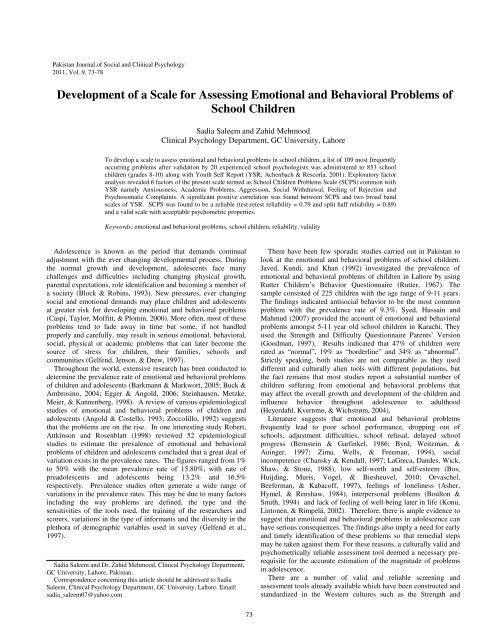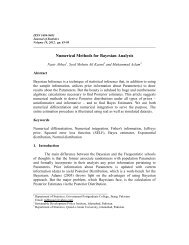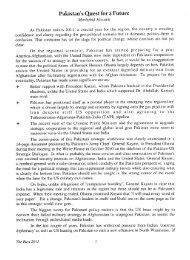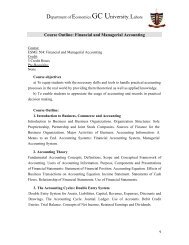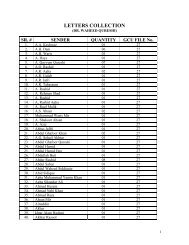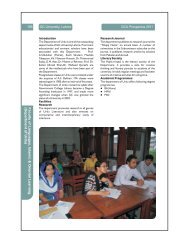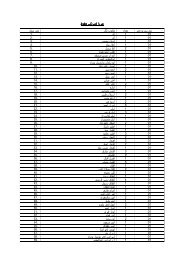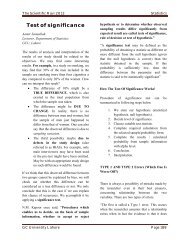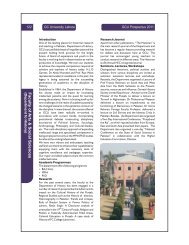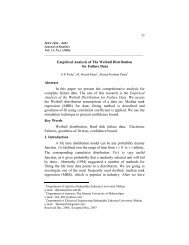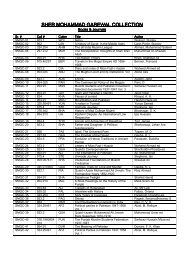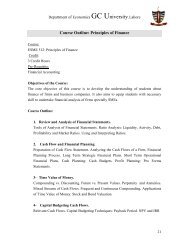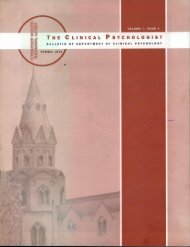Development of a Scale for Assessing Emotional and Behavioral ...
Development of a Scale for Assessing Emotional and Behavioral ...
Development of a Scale for Assessing Emotional and Behavioral ...
You also want an ePaper? Increase the reach of your titles
YUMPU automatically turns print PDFs into web optimized ePapers that Google loves.
Pakistan Journal <strong>of</strong> Social <strong>and</strong> Clinical Psychology<br />
2011, Vol. 9, 73-78<br />
<strong>Development</strong> <strong>of</strong> a <strong>Scale</strong> <strong>for</strong> <strong>Assessing</strong> <strong>Emotional</strong> <strong>and</strong> <strong>Behavioral</strong> Problems <strong>of</strong><br />
School Children<br />
Sadia Saleem <strong>and</strong> Zahid Mehmood<br />
Clinical Psychology Department, GC University, Lahore<br />
To develop a scale to assess emotional <strong>and</strong> behavioral problems in school children, a list <strong>of</strong> 109 most frequently<br />
occurring problems after validation by 20 experienced school psychologists was administered to 853 school<br />
children (grades 8-10) along with Youth Self Report (YSR; Achenbach & Rescorla, 2001). Exploratory factor<br />
analysis revealed 6 factors <strong>of</strong> the present scale termed as School Children Problems <strong>Scale</strong> (SCPS) common with<br />
YSR namely Anxiousness, Academic Problems, Aggression, Social Withdrawal, Feeling <strong>of</strong> Rejection <strong>and</strong><br />
Psychosomatic Complaints. A significant positive correlation was found between SCPS <strong>and</strong> two broad b<strong>and</strong><br />
scales <strong>of</strong> YSR. SCPS was found to be a reliable (test-retest reliability = 0.79 <strong>and</strong> split half reliability = 0.89)<br />
<strong>and</strong> a valid scale with acceptable psychometric properties.<br />
Keywords: emotional <strong>and</strong> behavioral problems, school children, reliability, validity<br />
Adolescence is known as the period that dem<strong>and</strong>s continual<br />
adjustment with the ever changing developmental process. During<br />
the normal growth <strong>and</strong> development, adolescents face many<br />
challenges <strong>and</strong> difficulties including changing physical growth,<br />
parental expectations, role identification <strong>and</strong> becoming a member <strong>of</strong><br />
a society (Block & Robins, 1993). New pressures, ever changing<br />
social <strong>and</strong> emotional dem<strong>and</strong>s may place children <strong>and</strong> adolescents<br />
at greater risk <strong>for</strong> developing emotional <strong>and</strong> behavioral problems<br />
(Caspi, Taylor, M<strong>of</strong>fitt, & Plomin, 2000). More <strong>of</strong>ten, most <strong>of</strong> these<br />
problems tend to fade away in time but some, if not h<strong>and</strong>led<br />
properly <strong>and</strong> carefully, may result in serious emotional, behavioral,<br />
social, physical or academic problems that can later become the<br />
source <strong>of</strong> stress <strong>for</strong> children, their families, schools <strong>and</strong><br />
communities (Gelfend, Jenson, & Drew, 1997).<br />
Throughout the world, extensive research has been conducted to<br />
determine the prevalence rate <strong>of</strong> emotional <strong>and</strong> behavioral problems<br />
<strong>of</strong> children <strong>and</strong> adolescents (Barkmann & Markwort, 2005; Buck &<br />
Ambrosino, 2004; Egger & Angold, 2006; Steinhausen, Metzke,<br />
Meier, & Kannenberg, 1998). A review <strong>of</strong> various epidemiological<br />
studies <strong>of</strong> emotional <strong>and</strong> behavioral problems <strong>of</strong> children <strong>and</strong><br />
adolescents (Angold & Costello, 1993; Zoccolillo, 1992) suggests<br />
that the problems are on the rise. In one interesting study Robert,<br />
Attkinson <strong>and</strong> Rosenblatt (1998) reviewed 52 epidemiological<br />
studies to estimate the prevalence <strong>of</strong> emotional <strong>and</strong> behavioral<br />
problems <strong>of</strong> children <strong>and</strong> adolescents concluded that a great deal <strong>of</strong><br />
variation exists in the prevalence rates. The figures ranged from 1%<br />
to 50% with the mean prevalence rate <strong>of</strong> 15.80%, with rate <strong>of</strong><br />
preadolescents <strong>and</strong> adolescents being 13.2% <strong>and</strong> 16.5%<br />
respectively. Prevalence studies <strong>of</strong>ten generate a wide range <strong>of</strong><br />
variations in the prevalence rates. This may be due to many factors<br />
including the way problems are defined, the type <strong>and</strong> the<br />
sensitivities <strong>of</strong> the tools used, the training <strong>of</strong> the researchers <strong>and</strong><br />
scorers, variations in the type <strong>of</strong> in<strong>for</strong>mants <strong>and</strong> the diversity in the<br />
plethora <strong>of</strong> demographic variables used in survey (Gelfend et al.,<br />
1997).<br />
Sadia Saleem <strong>and</strong> Dr. Zahid Mehmood, Clinical Psychology Department,<br />
GC University, Lahore, Pakistan.<br />
Correspondence concerning this article should be addressed to Sadia<br />
Saleem, Clinical Psychology Department, GC University, Lahore. Email:<br />
sadia_saleem07@yahoo.com<br />
There have been few sporadic studies carried out in Pakistan to<br />
look at the emotional <strong>and</strong> behavioral problems <strong>of</strong> school children.<br />
Javed, Kundi, <strong>and</strong> Khan (1992) investigated the prevalence <strong>of</strong><br />
emotional <strong>and</strong> behavioral problems <strong>of</strong> children in Lahore by using<br />
Rutter Children’s Behavior Questionnaire (Rutter, 1967). The<br />
sample consisted <strong>of</strong> 225 children with the age range <strong>of</strong> 9-11 years.<br />
The findings indicated antisocial behavior to be the most common<br />
problem with the prevalence rate <strong>of</strong> 9.3%. Syed, Hussain <strong>and</strong><br />
Mahmud (2007) provided the account <strong>of</strong> emotional <strong>and</strong> behavioral<br />
problems amongst 5-11 year old school children in Karachi. They<br />
used the Strength <strong>and</strong> Difficulty Questionnaire Parents’ Version<br />
(Goodman, 1997). Results indicated that 47% <strong>of</strong> children were<br />
rated as “normal”, 19% as “borderline” <strong>and</strong> 34% as “abnormal”.<br />
Strictly speaking, both studies are not comparable as they used<br />
different <strong>and</strong> culturally alien tools with different populations, but<br />
the fact remains that most studies report a substantial number <strong>of</strong><br />
children suffering from emotional <strong>and</strong> behavioral problems that<br />
may affect the overall growth <strong>and</strong> development <strong>of</strong> the children <strong>and</strong><br />
influence behavior throughout adolescence to adulthood<br />
(Heyerdahl, Kvernmo, & Wichstrøm, 2004).<br />
Literature suggests that emotional <strong>and</strong> behavioral problems<br />
frequently lead to poor school per<strong>for</strong>mance, dropping out <strong>of</strong><br />
schools, adjustment difficulties, school refusal, delayed school<br />
progress (Bernstein & Garfinkel, 1986; Byrd, Weitzman, &<br />
Auinger, 1997; Zima, Wells, & Freeman, 1994), social<br />
incompetence (Chansky & Kendall, 1997; LaGreca, D<strong>and</strong>es, Wick,<br />
Shaw, & Stone, 1988), low self-worth <strong>and</strong> self-esteem (Bos,<br />
Huijding, Muris, Vogel, & Biesheuvel, 2010; Orvaschel,<br />
Beeferman, & Kabac<strong>of</strong>f, 1997), feelings <strong>of</strong> loneliness (Asher,<br />
Hymel, & Renshaw, 1984), interpersonal problems (Boulton &<br />
Smith, 1994) <strong>and</strong> lack <strong>of</strong> feeling <strong>of</strong> well-being later in life (Konu,<br />
Lintonen, & Rimpelä, 2002). There<strong>for</strong>e, there is ample evidence to<br />
suggest that emotional <strong>and</strong> behavioral problems in adolescence can<br />
have serious consequences. The findings also imply a need <strong>for</strong> early<br />
<strong>and</strong> timely identification <strong>of</strong> these problems so that remedial steps<br />
may be taken against them. For these reasons, a culturally valid <strong>and</strong><br />
psychometrically reliable assessment tool deemed a necessary prerequisite<br />
<strong>for</strong> the accurate estimation <strong>of</strong> the magnitude <strong>of</strong> problems<br />
in adolescence.<br />
There are a number <strong>of</strong> valid <strong>and</strong> reliable screening <strong>and</strong><br />
assessment tools already available which have been constructed <strong>and</strong><br />
st<strong>and</strong>ardized in the Western cultures such as the Strength <strong>and</strong><br />
73
SALEEM & MEHMOOD 74<br />
Difficulty Questionnaire (SDQ; Goodman, 1997). SDQ is a brief<br />
mental health questionnaire that consists <strong>of</strong> 25 items grouped into 5<br />
sub-scales covering conduct problems, hyperactivity, emotional,<br />
peer problems <strong>and</strong> prosocial behavior. Separate versions <strong>for</strong><br />
teachers <strong>and</strong> parents are available covering an age range <strong>of</strong> 4-16<br />
years (Goodman, 1997). Another most frequently <strong>and</strong> widely used<br />
assessment tool is the Child Behavior Checklist (CBCL, Achenbach<br />
& Rescorla, 2001) in parent (Parent Report Form; PRF), teacher<br />
(Teacher Report Form; TRF) <strong>and</strong> <strong>for</strong> youth (Youth Self Report;<br />
YSR). CBCL has been used in many studies in different countries to<br />
assess emotional <strong>and</strong> behavioral problems <strong>of</strong> children (e.g. Kazdin,<br />
1989; Larsson & Frisk, 1999; Slobodskaya, 1999). CBCL consists<br />
<strong>of</strong> 112 items measuring two broad b<strong>and</strong> scales called Internalizing<br />
<strong>and</strong> Externalizing problems.<br />
A great deal <strong>of</strong> research is now focusing on the impact <strong>of</strong> culture<br />
on different psychological constructs <strong>and</strong> psychopathology (Chen,<br />
Rubin, & Li, 1995; Draguns &Tanaka-Matsumi, 2003). Researchers<br />
also argue that cultural value system <strong>and</strong> practices give an<br />
indigenous meaning to a social behavior (Wang & Ollendick,<br />
2001). The development, experience, expression <strong>and</strong> manifestation<br />
<strong>of</strong> mental health problems are influenced by cultural experiences<br />
(e.g., Thakker & Ward, 1998; Weisz, Weiss, Suwanlert, &<br />
Chaiyasit, 2003).<br />
Although it can be said that while some pathological behaviors<br />
(e.g. psychoses <strong>and</strong> other organic disorders) may manifest in a more<br />
or less universal way across cultures, <strong>and</strong> virtually are recognized<br />
by all as abnormal, some other <strong>for</strong>ms <strong>of</strong> behaviors (e.g., neurotic<br />
disorders, emotional <strong>and</strong> behavioral problems) are more likely to be<br />
a product <strong>of</strong> individuals’ own experiences, family <strong>and</strong> social<br />
interaction <strong>and</strong> cultural environment (Eisenberg, Pidada, & Liew,<br />
2001; Saleem & Mahmood, 2009). Moreover, the extent to which<br />
such behaviors are perceived as normal or abnormal is usually a<br />
matter <strong>of</strong> social judgment <strong>and</strong> <strong>of</strong> the culture in which they are<br />
observed, rather than the behavior itself (Gelfend et al., 1997).<br />
Such cultural variations <strong>and</strong> diversities in experience, expression<br />
<strong>and</strong> manifestation <strong>of</strong> mental health problems also question the use<br />
<strong>of</strong> assessment <strong>and</strong> screening tools which are developed in different<br />
cultures with different languages <strong>and</strong> are based on different<br />
phenomenological experiences (Gergen, Gulerce, Lock, & Misra,<br />
1996). These instruments <strong>and</strong> tools are more likely to give<br />
inaccurate <strong>and</strong> invalid results ultimately raising questions about the<br />
validity <strong>of</strong> the research (Kim, 2002). It is also very important to<br />
consider that some constructs are relevant to one culture but not <strong>for</strong><br />
others. By using these tools which are developed exclusively in<br />
Western culture with different linguistic expression, we may lose<br />
some <strong>of</strong> the important <strong>and</strong> crucial in<strong>for</strong>mation specifically related to<br />
non-Western cultures (Stewart et al., 1999). The blind application <strong>of</strong><br />
culturally alien tools not only leads to misinterpretation <strong>of</strong> the<br />
problems under study but may also mislead prevention <strong>and</strong><br />
treatment ef<strong>for</strong>ts (Kim, 2002). There<strong>for</strong>e, a plethora <strong>of</strong> literature is<br />
now focusing on cultural meaning <strong>of</strong> the psychological concepts<br />
<strong>and</strong> constructs (e.g., Draguns & Tanaka-Matsumi, 2003; Wang &<br />
Ollendick, 2001).<br />
The above discussion provides a rationale <strong>for</strong> developing an<br />
indigenous scale <strong>for</strong> measuring the emotional <strong>and</strong> behavioral<br />
problems based on the cultural <strong>and</strong> social background <strong>of</strong> Pakistani<br />
school children. Pakistan is a collectivistic society where family <strong>and</strong><br />
group values play a vital role in developing <strong>and</strong> shaping behaviors<br />
<strong>of</strong> the individuals <strong>and</strong> where familial harmony, obedience <strong>and</strong><br />
con<strong>for</strong>mity to parents <strong>and</strong> other authority figures are valued<br />
(Stewart et al., 1999). There<strong>for</strong>e, the psychological <strong>and</strong> mental<br />
health is greatly influenced by the people around them (Markus &<br />
Kitayama, 1991). However, very few systematic ef<strong>for</strong>ts have been<br />
attempted to assess <strong>and</strong> measure mental health problems <strong>of</strong> school<br />
children <strong>and</strong> adolescents in the Pakistani cultural context.<br />
There<strong>for</strong>e, the objectives <strong>of</strong> this study are to identify the experience,<br />
expression <strong>and</strong> manifestation <strong>of</strong> emotional <strong>and</strong> behavioral problems<br />
<strong>of</strong> children within cultural context <strong>of</strong> Pakistan <strong>and</strong> to develop a<br />
valid <strong>and</strong> reliable scale <strong>for</strong> this purpose.<br />
Method<br />
The scale was developed in three stages. Stage 1 describes the<br />
gathering <strong>and</strong> collating procedure <strong>of</strong> emotional <strong>and</strong> behavioral<br />
problems, followed by stage II <strong>of</strong> empirical validation <strong>and</strong> in the<br />
stage III the psychometric properties <strong>of</strong> the scale were established.<br />
Stage 1: Gathering Problems<br />
Initially, the presenting problems <strong>of</strong> 103 referred school children<br />
were gathered <strong>and</strong> collated through their initial interview with the<br />
school psychologists over a period <strong>of</strong> 6 months. These 103 children<br />
had been referred by school authorities <strong>for</strong> various mental health<br />
problems. A list <strong>of</strong> 129 problems was prepared. All those items that<br />
were dubious, vague or overlapping were merged or modified<br />
keeping close to their original connotations. Items that were<br />
expressed in idiosyncratic or slang words were also excluded. In<br />
this way, a final list <strong>of</strong> 119 problems was collated <strong>and</strong> given the<br />
name <strong>of</strong> School Children’s Problems <strong>Scale</strong> (SCPS).<br />
Stage 2: Empirical Validation Through Experts<br />
In order to gather empirical validation <strong>of</strong> the final list <strong>of</strong><br />
emotional <strong>and</strong> behavioral problems, 20 experienced school<br />
psychologists were in<strong>for</strong>med about the purpose <strong>of</strong> the research. All<br />
participants had a minimum 3 years <strong>of</strong> experience with school<br />
children. They were asked to rate each <strong>of</strong> the 119 problems on a 6-<br />
point rating scale ranging from 0 = “not at all” to 5 = “extremely<br />
common” <strong>for</strong> their frequency <strong>of</strong> occurrence in school children.<br />
At the end <strong>of</strong> stage II, all the problems were listed in descending<br />
order <strong>of</strong> frequency <strong>of</strong> occurrence as rated by the experts. Problems<br />
getting less than 20% average score were excluded from the final<br />
list. In this way, a final list <strong>of</strong> 111 problems was retained <strong>and</strong> used<br />
<strong>for</strong> further psychometric properties in stage III.<br />
Pilot Study<br />
Hundred <strong>and</strong> eleven problems were piloted on 60 school children<br />
(30 boys <strong>and</strong> 30 girls) <strong>for</strong> readability <strong>and</strong> to test the layout. Two<br />
problems were excluded from the scale because their wording was<br />
not clear to some children. In this way, 109 problems were retained<br />
<strong>for</strong> further psychometric phase.<br />
Stage 3: Psychometric Properties<br />
Stage III was aimed at establishing the factorial structure, validity<br />
<strong>and</strong> reliability <strong>of</strong> the final set <strong>of</strong> statements termed as School<br />
Children Problem <strong>Scale</strong> (SCPS). A multistage sampling technique<br />
was used to select the sample. In the first stage, stratified sampling<br />
technique was used to divide the sample into two main strata comprising<br />
<strong>of</strong> boys <strong>and</strong> girls <strong>of</strong> government schools <strong>of</strong> Lahore. In the
SCHOOL CHILDREN’S PROBLEM SCALE 75<br />
Table 1<br />
Sample description <strong>of</strong> the participants<br />
Variables<br />
Boys Girls Total<br />
(n = 438) (n = 415) (n = 853)<br />
Gender 51.36 48.64 100<br />
Class<br />
8 th 16.19 15.21 31.40<br />
9 th 17.12 16.60 33.72<br />
10 th 18.05 16.83 34.88<br />
second stage, two main strata were further divided into three substrata<br />
according to grades, i.e., 8 th , 9 th <strong>and</strong> 10 th . Within each strata,<br />
the participants were selected r<strong>and</strong>omly. The final sample consisted<br />
<strong>of</strong> 853 school children (boys = 438, girls = 415) <strong>of</strong> grades 8 th , 9 th<br />
<strong>and</strong> 10 th . The mean age <strong>of</strong> the sample was 13.91 (SD = 1.27). The<br />
sample was collected from 10 mainstream government schools <strong>of</strong><br />
Lahore (Table 1).<br />
Instruments<br />
1. School Children’s Problems <strong>Scale</strong> (SCPS). School Children’s<br />
Problems <strong>Scale</strong> (SCPS) developed in the earlier stages consists <strong>of</strong><br />
109 problems experienced <strong>and</strong> expressed by school children <strong>and</strong> is a<br />
4-point rating scale with options included “Never, Rarely,<br />
Sometimes, <strong>and</strong> Often”.<br />
2. Youth Self Report (YSR; Achenbach & Rescorla, 2001). The<br />
Youth Version <strong>of</strong> Child Behavior Checklist i.e., Youth Self Report<br />
(YSR, Achenbach & Rescorla, 2001) was used. It consists <strong>of</strong> 112<br />
items <strong>for</strong> ages 11-18 years <strong>and</strong> describes a broad range <strong>of</strong> problems.<br />
As mentioned earlier, it is one <strong>of</strong> the most frequently used measures<br />
to assess emotional <strong>and</strong> behavioral problems <strong>of</strong> children. There<strong>for</strong>e,<br />
in order to establish the concurrent validity <strong>of</strong> SCPS, Urdu (national<br />
language <strong>of</strong> Pakistan) version <strong>of</strong> YSR was used.<br />
Procedure<br />
Initially, 16 schools were contacted <strong>and</strong> a brief description <strong>of</strong> the<br />
aims <strong>of</strong> the current research was sent to them. Ten schools agreed to<br />
participate. Each school was personally visited by the researcher<br />
<strong>and</strong> school authorities were in<strong>for</strong>med about the objectives <strong>of</strong> the<br />
research. They were assured that all the in<strong>for</strong>mation would be kept<br />
confidential <strong>and</strong> will only be used <strong>for</strong> research purposes. Once<br />
permission was granted, the school authorities were asked to<br />
provide one section at r<strong>and</strong>om from 8 th , 9 th <strong>and</strong> 10 th class. Children<br />
<strong>of</strong> each class were tested in group settings with an average <strong>of</strong> 30<br />
children in each class.<br />
Firstly, the researcher introduced herself to the participants <strong>and</strong><br />
in<strong>for</strong>med about the purpose <strong>of</strong> the research. All those who agreed to<br />
participate were then provided the final testing protocol comprising<br />
Table 2<br />
Eigen Values <strong>and</strong> Variance Explained by 6 Factors <strong>of</strong> SCPS<br />
Factors Eigen values % <strong>of</strong> variance % <strong>of</strong> total variance<br />
1 16.46 18.49 18.49<br />
2 4.06 4.55 23.05<br />
3 2.74 3.08 26.13<br />
4 1.99 2.24 28.37<br />
5 1.75 1.97 30.34<br />
6 1.66 1.86 32.20<br />
<strong>of</strong> SCPS <strong>and</strong> CBCL. All participants were assured that it’s not an<br />
exam <strong>and</strong> there are no right <strong>and</strong> wrong answers. They were also<br />
assured that their in<strong>for</strong>mation will be kept confidential <strong>and</strong> had<br />
nothing to do with the school authorities. The instructions were<br />
given in Urdu. They were asked to rate each problem to the extent it<br />
bothered them. It took about 25 minutes to complete the protocol.<br />
After completion, each group was given about 20 minutes <strong>for</strong> any<br />
questions, feedback <strong>and</strong> debriefing.<br />
Results<br />
Factor Analysis <strong>of</strong> School Children’s Problems <strong>Scale</strong> (SCPS)<br />
Principle Component Analysis with Varimax Rotation <strong>and</strong><br />
Scree Plot was used to explore the factor structure <strong>of</strong> SCPS. Factors<br />
were also extracted on the basis <strong>of</strong> Eigen value > 1. On the basis <strong>of</strong><br />
factor analysis, factor loadings were assessed. Items with loading <strong>of</strong><br />
Table 3<br />
Sample Items <strong>of</strong> Six Factors <strong>of</strong> SCPS<br />
Factor 1: Anxiousness (23 items)<br />
1. Easily get worried<br />
2. Fear to take initiative<br />
3. Feeling shy<br />
4. Pointless thoughts<br />
5. Fear <strong>of</strong> unknown<br />
Factor 2: Academic Problems (16 items)<br />
1. Lack <strong>of</strong> interest in studies<br />
2. Problems related to home work <strong>and</strong> school work<br />
3. Inability to concentrate<br />
4. Lack <strong>of</strong> confidence<br />
Factor 3: Aggression (15 items)<br />
1. Losing temper easily<br />
2. Inability to sit still<br />
3. Throwing things away in anger<br />
4. Abusive, <strong>and</strong> argues a lot<br />
Factor 4: Social withdrawal (15 items)<br />
1. Avoiding social interaction<br />
2. Indulging in daydreaming<br />
3. Avoiding friends<br />
4. Feeling shy<br />
Factor 5: Feelings <strong>of</strong> Rejection (10 items)<br />
1. Feelings <strong>of</strong> being rejected by teachers <strong>and</strong> parents,<br />
2. Unnecessary interference by parents<br />
3. Nobody listens me<br />
Factor 6: Psychosomatic Problems (15 items)<br />
1. Physical aches <strong>and</strong> pains<br />
2. Headache<br />
3. Feelings <strong>of</strong> nausea<br />
4. Feeling sick<br />
Table 4<br />
Cronbach Alpha <strong>of</strong> SCPS <strong>and</strong> 6 Factors<br />
Factors No <strong>of</strong> items α<br />
Anxiousness 23 0.87<br />
Academic Problems 16 0.84<br />
Aggression 15 0.84<br />
Social Withdrawal 15 0.83<br />
Rejection 10 0.70<br />
Psychosomatic Problems 9 0.76<br />
Total SCPS Score 88 0.92
SALEEM & MEHMOOD 76<br />
Table 5<br />
Summary <strong>of</strong> Intercorrelation, Means <strong>and</strong> St<strong>and</strong>ard Deviations <strong>for</strong> Six Factors <strong>and</strong> Total Score <strong>of</strong> SCPS<br />
Factors 1 2 3 4 5 6 7<br />
1. Anxiousness --- .63** .41** .72** .57** .59** .89**<br />
2. Academic Problems --- --- .57** .55** .59** .39** .81**<br />
3. Aggression --- --- --- .44** .39* .29* .66**<br />
4. Withdrawal --- --- --- --- .53** .54** .83**<br />
5. Rejection --- --- --- --- --- .39* .72**<br />
6. Psychosomatic Problems --- --- --- --- --- --- .66**<br />
7. Total Score --- --- --- --- --- --- ---<br />
M 24.41 18.20 17.72 16.11 6.08 14.93 78.53<br />
SD 13.04 10.68 9.39 8.74 5.02 8.06 35.42<br />
*p < .01. ** p < .001.<br />
.3 or below were eliminated. Eighty eight items were distributed<br />
across 6 factors.<br />
Table 2 indicates the factorial structure <strong>of</strong> SCPS. Scree plot<br />
revealed six factor solutions <strong>of</strong> SCPS. A descriptive label was<br />
assigned to each factor on the basis <strong>of</strong> commonality <strong>of</strong> items in the<br />
factors. The details <strong>of</strong> these six factors are given in Table 3.<br />
Validity <strong>and</strong> Reliability<br />
Concurrent Validity<br />
Concurrent validity <strong>of</strong> SCPS was confirmed with YSR. A<br />
significant positive correlation was found between School<br />
Children’s Problems <strong>Scale</strong> (SCPS) <strong>and</strong> two broad b<strong>and</strong> scales <strong>of</strong><br />
YSR namely Internalizing Problems (r = 0.76, p < 0.001) <strong>and</strong><br />
Externalizing Problems (r = 0.70, p < 0.001).<br />
Table 4 indicates that SCPS has a high internal consistency. Table 5<br />
indicates a significant positive correlation among six factors <strong>and</strong> the<br />
Total Score <strong>of</strong> SCPS.<br />
Test Retest Reliability<br />
One week test retest reliability on 20% (n = 115) sample was r =<br />
0.79, p < 0.001.<br />
Split Half Reliability<br />
Odd <strong>and</strong> even method was used to determine the split half<br />
reliability <strong>of</strong> SCPS showing r = 0.89, p < 0.001.<br />
Discussion<br />
The present study focused on the culture specific experience <strong>and</strong><br />
expression <strong>of</strong> emotional <strong>and</strong> behavioral problems <strong>of</strong> school<br />
children. Initially, a list <strong>of</strong> 129 problems was collated from 103<br />
referred school children. After linguistic modification, a list <strong>of</strong> 119<br />
items was further validated through 20 experienced school<br />
psychologists. The final list <strong>of</strong> 109 problems (School Children’s<br />
Problem <strong>Scale</strong>, SCPS) was administered to 853 school children.<br />
Principle Component factor analysis revealed a six factor solution<br />
<strong>of</strong> SCPS namely Anxiousness, Academic Problems, Aggression,<br />
Social Withdrawal, Feeling <strong>of</strong> Rejection <strong>and</strong> Psychosomatic<br />
Problems. While the four factors Anxiousness, Aggression, Social<br />
Withdrawal <strong>and</strong> Psychosomatic Problems were found to be<br />
consistent with the literature (e.g., Achenbach & Rescorla, 2001).<br />
The factors, Academic Problems <strong>and</strong> Feelings <strong>of</strong> Rejection were<br />
peculiar <strong>for</strong> this sample.<br />
Factor 1 <strong>of</strong> SCPS consisted <strong>of</strong> 23 problems related to anxiety,<br />
worry <strong>and</strong> indulging in pointless thoughts. School children are<br />
perhaps over concerned about how they are viewed <strong>and</strong> evaluated<br />
by their teachers, parents <strong>and</strong> peer group. More specifically,<br />
children <strong>and</strong> adolescents <strong>of</strong> these grades (8 th , 9 th <strong>and</strong> 10 th ) are more<br />
anxious about their school per<strong>for</strong>mance <strong>and</strong> this may influence the<br />
manifestation <strong>of</strong> problems.<br />
Academic problems stood out very prominently in SCPS. In<br />
educational system in Pakistan, these three years, i.e., 8 th , 9 th <strong>and</strong><br />
10 th grades are very crucial <strong>and</strong> critical in every child’s academic<br />
life. These grades play a vital role in the choice <strong>of</strong> career in the<br />
future. As noted in other studies (Isralowitz & Ong, 1990) that<br />
school adjustment <strong>and</strong> choice <strong>of</strong> career are the top concerns <strong>of</strong><br />
adolescents living in Asian countries. There<strong>for</strong>e, it may be possible<br />
that the pressure the child feels in school may bring out some <strong>of</strong> the<br />
emotional <strong>and</strong> behavioral problems that may lead to declined school<br />
per<strong>for</strong>mance. This particular factor <strong>of</strong> academic problems did not<br />
emerge in other similar studies (e.g. Achenbach, 1991; Goodman,<br />
1997) which may reflect the different nature <strong>of</strong> the samples.<br />
The third factor that emerged in factor analysis was Aggression.<br />
This factor consists <strong>of</strong> that items related to direct or indirect<br />
expression <strong>of</strong> anger <strong>and</strong> aggression. This factor is consistent with<br />
other scales (YSR, Achenbach & Rescorla, 2001), where it was<br />
reflective <strong>of</strong> externalizing problems. This factor shows the typical<br />
pattern <strong>of</strong> school children where they have to excel collectively as<br />
well as individually. There<strong>for</strong>e, they may manifest more aggressive<br />
behaviors <strong>and</strong> activities. Other two factors namely Social<br />
Withdrawal <strong>and</strong> Psychosomatic Problems are also consistent with<br />
the literature. Studies have revealed that Asian adolescents tend to<br />
manifest their emotional <strong>and</strong> behavioral problems in terms <strong>of</strong><br />
somatic complaints (Kim, 2002).<br />
The other interesting <strong>and</strong> significant factor that emerged in the<br />
sample was Feeling <strong>of</strong> Rejection. This factor is perhaps more<br />
conspicuous in collectivistic culture like Pakistan than it may be in<br />
the West. Collectivistic culture is marked by overdependence <strong>of</strong> the
SCHOOL CHILDREN’S PROBLEM SCALE 77<br />
child on the family. Family, parents, siblings <strong>and</strong> teachers plays a<br />
vital role in shaping <strong>and</strong> molding a child’s behavior. The child<br />
rearing practices are more traditional where familial harmony,<br />
obedience <strong>and</strong> con<strong>for</strong>mity to parents <strong>and</strong> other authority figures are<br />
valued (Stewart et al., 1999). In the traditional Asian cultures like<br />
Pakistan, childhood period is somewhat prolonged in which<br />
dependence on parents is encouraged <strong>and</strong> children are expected to<br />
respect (Chao, 1994). The family structure is larger, predominately<br />
living in joint family system <strong>and</strong> more hierarchal than in the West.<br />
Children <strong>of</strong> traditional societies are more likely to regress under<br />
pressure than those <strong>of</strong> the Western culture, where they are<br />
encouraged to develop individuality, autonomy <strong>and</strong> independence.<br />
The psychometric properties <strong>of</strong> SCPS were encouraging. The<br />
internal consistency <strong>of</strong> SCPS was established using Cronbach<br />
Alpha, which was 0.92 <strong>for</strong> the whole scale with 88 items after factor<br />
analysis, while the reliability coefficients also showed that the<br />
SCPS was found to have high internal consistency. As the items <strong>of</strong><br />
SCPS were based on the direct experience <strong>and</strong> expression <strong>of</strong> school<br />
children <strong>and</strong> were further validated by experts, there<strong>for</strong>e the scale<br />
satisfied the criteria <strong>of</strong> face <strong>and</strong> content validity.<br />
As far as the concurrent validity was concerned, YSR<br />
(Achenbach & Rescorla, 2001) was used. A significant positive<br />
correlation was found between total SCPS score <strong>and</strong> two broad<br />
b<strong>and</strong> scales <strong>of</strong> CBCL, with Internalizing problems <strong>and</strong> with<br />
Externalizing problems. One week test retest reliability <strong>of</strong> SCPS<br />
was also high.<br />
The scale (SPCS) was divided into two equal halves by using odd<br />
<strong>and</strong> even method to establish the split half reliability which was also<br />
high. High split-half reliability may provide the short versions <strong>of</strong><br />
SCPS <strong>for</strong> quick screening <strong>for</strong> emotional <strong>and</strong> behavioral problems <strong>of</strong><br />
school children.<br />
The present study has contributed significantly by discovering the<br />
culture specific experience <strong>and</strong> expression <strong>of</strong> emotional <strong>and</strong><br />
behavioral problems in Pakistani culture. The School Children’s<br />
Problems <strong>Scale</strong> (SCPS) with acceptable psychometric properties<br />
does have the potential to be used in research. This scale may also<br />
be used to monitor progress <strong>and</strong> effectiveness in therapy, counseling<br />
<strong>and</strong> guidance <strong>of</strong> school children. The present research is also an<br />
attempt to develop an assessment scale measuring different<br />
dimensions <strong>of</strong> emotional <strong>and</strong> behavioral problems <strong>of</strong> school<br />
children <strong>and</strong> is largely based on the empirically derived data as<br />
proposed by Achenbach (1991). This study also emphasizes the use<br />
<strong>of</strong> functional pr<strong>of</strong>ile <strong>of</strong> the child rather than using rigid diagnostic<br />
categories.<br />
Conclusion<br />
This study has addressed the important issue <strong>of</strong> culture specific<br />
manifestation <strong>and</strong> presentation <strong>of</strong> emotional <strong>and</strong> behavioral<br />
problems <strong>of</strong> school children. Results showed that academic<br />
problems <strong>and</strong> feelings <strong>of</strong> rejection are the essential features <strong>of</strong><br />
school children’s experience <strong>and</strong> expression <strong>of</strong> emotional <strong>and</strong><br />
behavioral problems. These problems are absent in most popular<br />
Western measures <strong>of</strong> emotional <strong>and</strong> behavioral problems. Problems<br />
such as anger <strong>and</strong> aggression, social withdrawal <strong>and</strong> psychosomatic<br />
problems found in Western measures are also found to be an<br />
integral <strong>and</strong> important part <strong>of</strong> mental health issues in our culture.<br />
We propose that these might be the core or universal expression<br />
found in any culture. With both core <strong>and</strong> culture specific expression<br />
<strong>of</strong> emotional <strong>and</strong> behavioral problems in SCPS, the accuracy <strong>of</strong><br />
assessing <strong>and</strong> screening mental health issues in school children can<br />
be enhanced. This study could also prove a basic measuring tool to<br />
determine the prevalence <strong>of</strong> emotional <strong>and</strong> behavioral problems <strong>of</strong><br />
school children so that we could have an accurate account <strong>of</strong> the<br />
magnitude <strong>of</strong> the problems.<br />
References<br />
Achenbach, T. M. (1991). Manual <strong>for</strong> the Child Behavior Checklist<br />
<strong>and</strong> 1991 pr<strong>of</strong>ile. Burlington, VT: University Vermont,<br />
Department <strong>of</strong> Psychiatry<br />
Achenbach, T. M., & Rescorla, L. A. (2001). Manual <strong>for</strong> the<br />
ASEBA School-Age <strong>for</strong>ma & pr<strong>of</strong>ile. Vermont University,<br />
Department <strong>of</strong> Psychiatry.<br />
Angold, A., & Costello, E. J. (1993). Depressive comorbidity in<br />
children <strong>and</strong> adolescents: Empirical, theoretical <strong>and</strong><br />
methodological issues. American Journal <strong>of</strong> Psychiatry,<br />
150(12), 1779-1791.<br />
Asher, S. R., Hymel, S., & Renshaw, P. D. (1984). Loneliness in<br />
children. Child <strong>Development</strong>, 55, 1456-1464.<br />
Barkmann, C., & Markwort, C. (2005). <strong>Emotional</strong> <strong>and</strong> behavioral<br />
problems <strong>of</strong> children <strong>and</strong> adolescents in Germany: An<br />
epidemiological screening. Social Psychiatry, Psychiatric<br />
Epidemiology, 40, 357–366.<br />
Bernstein, G. A., & Garfinkel, B. D. (1986). School phobia: The<br />
overlap <strong>of</strong> affective <strong>and</strong> anxiety disorders. Journal <strong>of</strong> the<br />
American Academy <strong>of</strong> Child Psychiatry, 25, 235-241.<br />
Block, J., & Robins, R. W. (1993). A longitudinal study <strong>of</strong><br />
consistency <strong>and</strong> change in selfesteem from early adolescence to<br />
early adulthood. Child <strong>Development</strong>, 64(3), 909-923.<br />
Bos, A. E. R., Huijding, J., Muris, P., Vogel, L. R. R., &<br />
Biesheuvel, J. (2010). Global, contingent <strong>and</strong> implicit selfesteem<br />
<strong>and</strong> psychopathological symptoms in adolescents.<br />
Personality <strong>and</strong> Individual Differences, 48, 311–316.<br />
Boulton, M. J., & Smith, P. K. (1994). Bully/victim problems in<br />
middle-school children: Stability, self perceived competence,<br />
peer perceptions <strong>and</strong> peer acceptance. British Journal <strong>of</strong><br />
<strong>Development</strong>al Psychology, 12, 315-329.<br />
Buck, K. A., & Ambrosino, R. J. (2004). Children with severe<br />
behavior problems: A survey <strong>of</strong> Texas child care centers'<br />
responses. Early Childhood Education Journal, 31(4), 241-246.<br />
Byrd, R. S., Weitzman, M., & Auinger, P. (1997). Increased<br />
behavior problems associated with delayed school entry <strong>and</strong><br />
delayed school progress. Pediatrics, 100, 654-661.<br />
Caspi, A., Taylor, A., M<strong>of</strong>fitt, T. E., & Plomin, R.<br />
(2000).Neighborhood deprivation affects children’s mental<br />
health: Environmental risks identified in a genetic design.<br />
Psychological Science, 11, 338-342.<br />
Chansky, T. E., & Kendall, P. C. (1997). Social expectancies <strong>and</strong><br />
self-perceptions in anxiety-disordered children. Journal <strong>of</strong><br />
Anxiety Disorders, 11, 347-363.<br />
Chao, R. K. (1994). Beyond parental control <strong>and</strong> authoritarian<br />
parenting style, underst<strong>and</strong>ing Chinese parenting through the<br />
cultural notion <strong>of</strong> training. Child <strong>Development</strong>, 65, 1111-1119.<br />
Chen, X., Rubin, K. H., & Li, Z. Y. (1995). Social functioning <strong>and</strong><br />
adjustment in Chinese children: A longitudinal study.<br />
<strong>Development</strong>al Psychology, 31, 531-539.<br />
Draguns, J. G., & Tanaka-Matsumi, J. (2003). Assessment <strong>of</strong><br />
psychopathology across <strong>and</strong> within cultures: issues <strong>and</strong><br />
findings. Behaviour Research <strong>and</strong> Therapy, 41, 755-776.<br />
Egger, H. L., & Angold, A. (2006). Common emotional <strong>and</strong><br />
behavioral disorders in preschool children: Presentation,
SALEEM & MEHMOOD 78<br />
nosology, <strong>and</strong> epidemiology. Journal <strong>of</strong> Child Psychology <strong>and</strong><br />
Psychiatry <strong>and</strong> Allied Disciplines, 47(3-4), 313-337.<br />
Eisenberg, N., Pidada, S., & Liew, J. (2001). The relations <strong>of</strong><br />
regulation <strong>and</strong> negative emotionality to Indonesian children’s<br />
social functioning. Child <strong>Development</strong>, 72, 1747-1763.<br />
Gelfend, D. M., Jenson, W. R., & Drew, C. J. (1997).<br />
Underst<strong>and</strong>ing Child Behavior Disorder (3 rd ed.). Australia:<br />
Wadsworth.<br />
Gergen, K. J., Gulerce, A., Lock, A., & Misra, G. (1996).<br />
Psychological science in a cultural context. American<br />
Psychologist, 51, 496-503.<br />
Goodman, R. (1997). The strengths <strong>and</strong> difficulties questionnaire: A<br />
research note. Journal <strong>of</strong> Child Psychology <strong>and</strong> Psychiatry, 38,<br />
581 -586.<br />
Heyerdahl, C., Kvernmo, S., & Wichstrøm, L. (2004). Self-reported<br />
behavioural/emotional problems in Norwegian adolescents from<br />
multiethnic areas. European Child <strong>and</strong> Adolescent Psychiatry,<br />
13, 64-72.<br />
Isralowitz, R. E., & Ong, T. H. (1990). Singapore youth: The<br />
impact <strong>of</strong> social status on perception <strong>of</strong> adolescent problems.<br />
Adolescence, 25, 358-362.<br />
Javed, M. A., Kundi, M. Z., & Khan, P. A. (1992). <strong>Emotional</strong> <strong>and</strong><br />
behavioral problems among school children in Pakistan.<br />
Journal <strong>of</strong> the Pakistan Medical Association, 42(8), 181-183.<br />
Kazdin, A. E. (1989). <strong>Development</strong>al psychology. Current research<br />
issues <strong>and</strong> direction. Journal <strong>of</strong> American Psychologist, 44(2),<br />
180-187.<br />
Kim, M. T. (2002). Measuring depression among Korean<br />
Americans: <strong>Development</strong> <strong>of</strong> the Kim depression scale <strong>for</strong><br />
Korean Americans. Journal <strong>of</strong> Transcultural Nursing, 13(2),<br />
109-117.<br />
Konu, T. P., Lintonen, M. K., & Rimpelä, A. (2002). Factors<br />
associated with School children's general subjective well-being.<br />
Health Education Research, 17(2), 155-165.<br />
LaGreca, A. M., D<strong>and</strong>es, S. K., Wick, P., Shaw, K., & Stone, W. L.<br />
(1988). <strong>Development</strong> <strong>of</strong> the social anxiety scale <strong>for</strong> children:<br />
Reliability <strong>and</strong> concurrent validity. Journal <strong>of</strong> Clinical Child<br />
Psychology, 17, 84-91.<br />
Larsson, B., & Frisk, M. (1999). Social competence <strong>and</strong><br />
emotional/behavior problems in 6-16 year old Swedish school<br />
children. European Child <strong>and</strong> Adolescent Psychiatry, 8, 24-33.<br />
Markus, H. R., & Kitayama, S. (1991). Culture <strong>and</strong> the self;<br />
Implications <strong>for</strong> cognition, emotion, <strong>and</strong> motivation.<br />
Psychological Review, 98, 224-253.<br />
Orvaschel, H., Beeferman, D., & Kabac<strong>of</strong>f, R. (1997). Depression,<br />
self-esteem, sex, <strong>and</strong> age in a child <strong>and</strong> adolescent clinical<br />
sample. Journal <strong>of</strong> Clinical Child Psychology, 26, 285-289.<br />
Robert, R. E., Attkinson, C. C., & Rosenblatt, A. (1998). Prevalence<br />
<strong>of</strong> psychopathology among children <strong>and</strong> adolescents. American<br />
Journal <strong>of</strong> Psychiatry, 155, 715-725.<br />
Rutter, M. A. (1967). Children’s behavior questionnaire <strong>for</strong><br />
completion by teachers, preliminary findings. Journal <strong>of</strong> Child<br />
Psychology Psychiatry, 8, 1-11.<br />
Saleem, S., & Mahmood, Z. (2009). OCD in a cultural context: A<br />
phenomenological approach. Pakistan Journal <strong>of</strong> Psychological<br />
Research, 24(1-2), 27-42.<br />
Slobodskaya, H. R. (1999). Competence, emotional <strong>and</strong> behavioural<br />
problems in Russian adolescents. European Child <strong>and</strong><br />
Adolescent Psychiatry, 8, 173-180.<br />
Steinhausen, H. C., Metzke, C. W., Meier, M., & Kannenberg, R.<br />
(1998). Prevalence <strong>of</strong> child <strong>and</strong> adolescent psychiatric<br />
disorders; the Zurich epidemiological study, Acta Psychiatric<br />
Sc<strong>and</strong>navica , 98, 262-271.<br />
Stewart, S. M., Bond, M. H., Zaman, R. M., McBride-Chang, C.,<br />
Rao, N., Ho, M. L., et al. (1999). Functional parenting in<br />
Pakistan. International Journal <strong>of</strong> <strong>Behavioral</strong> <strong>Development</strong>,<br />
23(3), 747-770.<br />
Syed, E. U., Hussain, S. A., & Mahmud, S. (2007). Screening <strong>for</strong><br />
emotional <strong>and</strong> behavioral problems amongst 5-11 years old<br />
school children in Karachi, Pakistan. Social Psychiatry,<br />
Psychiatric Epidemiology, 42, 421-427.<br />
Thakker, J., & Ward, T. (1998). Culture <strong>and</strong> classification: The<br />
cross-cultural application <strong>of</strong> the DSM-IV. Clinical Psychology<br />
Review, 18(5), 501–529.<br />
Wang ,Y., & Ollendick, T. H. (2001). A cross-cultural <strong>and</strong><br />
developmental analysis <strong>of</strong> self-esteem in Chinese <strong>and</strong> Western<br />
children. Clinical Child <strong>and</strong> Family Psychology Review, 4, 253-<br />
271.<br />
Weisz, J. R., Weiss, R., Sawanlert, S., & Chaiyasit, W. (2003).<br />
Syndromal structure <strong>of</strong> psychopathology in children <strong>of</strong><br />
Thail<strong>and</strong> <strong>and</strong> the United States. Journal <strong>of</strong> Consulting <strong>and</strong><br />
Clinical Psychology, 71, 375-385.<br />
Zima, B. T., Wells, K. B., & Freeman, H. E. (1994). <strong>Emotional</strong> <strong>and</strong><br />
behavioral problems <strong>and</strong> severe academic delays among<br />
sheltered homeless children in Los Angeles County. American<br />
Journal <strong>of</strong> Public Health, 84(2), 260-264.<br />
Zoccolillo, M. (1992). Co-occurrence <strong>of</strong> conduct disorder <strong>and</strong> its<br />
adult outcomes with depressive <strong>and</strong> anxiety disorders: A<br />
review. Journal <strong>of</strong> the American Academy <strong>of</strong> Child <strong>and</strong><br />
Adolescent Psychiatry, 31(3), 547-556.<br />
Received April, 2010<br />
Revision Received July, 2011<br />
Accepted August, 2011


